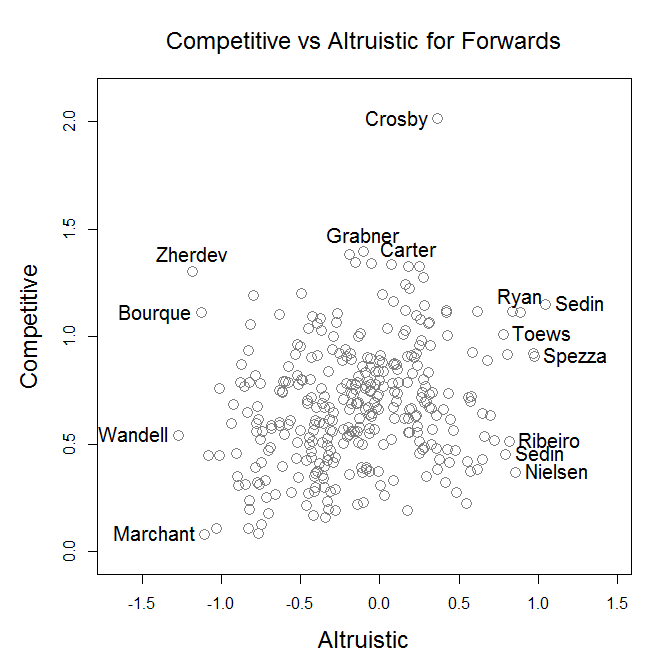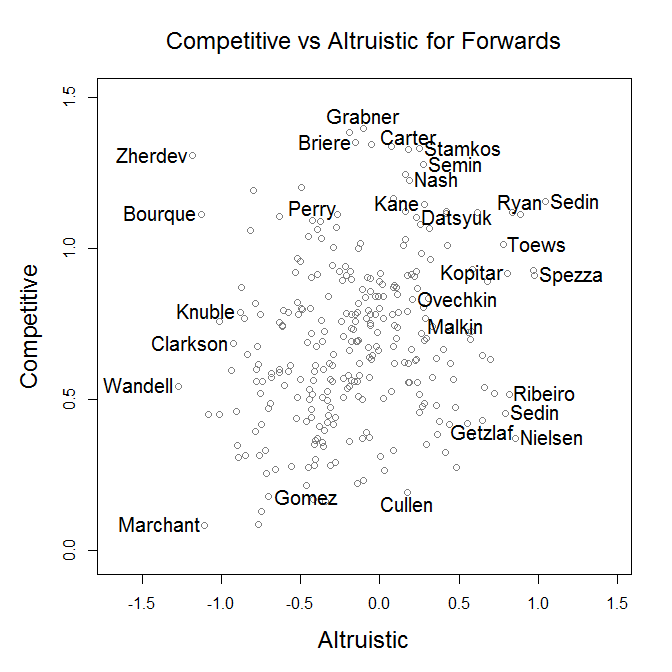By Brian Macdonald | July 30, 2013
Part 1 of this series on a new playmaking metric PLAY, we gave an overview, and discussed marginal contribution, which is basically some form of WOWY. See here for Part 1 and here for the full paper. In this part, we’ll discuss competitive and altruistic contributions. Altruistic contribution is what we’ll use to compute PLAY.
Competitive and Altruistic Contributions
So we have this WOWY for every player, and we are going to decompose it into two parts, competitive contribution (Comp) and altruistic contribution (Alt). A player’s competitive contribution is simply the goals per 60 minute that he scores. A player’s altruistic contribution is everything else, or his WOWY with his goals per 60 minutes taken out:
\[ Alt = WOWY – Comp\]
Altruistic contribution is basically the difference in the goals scored by a player’s teammates (not including the goals that the player himself scored) when he is in on the ice versus when he is off the ice. In other words, it is a measure of how he affects his teammates’ goal scoring. If his teammates score more goals with him than without him, he’ll have a high altruistic contribution, regardless of whether or not he scores many of the goals.
So his WOWY is broken into two parts:
\[ WOWY = Comp + Alt \]
The competitive and altruistic contribution could also be thought of as selfish and unselfish contributions, although we kind of think selfish has too negative of a connotation to use this terminology. Scoring goals should not have a negative connotation. Thinking of altruistic contributions as unselfish contributions is ‘aight though.
Let’s look at a couple of pictures. First, since this altruistic contribution is a measure of how a player affects his teammates’ goal scoring, it should be correlated with assists. Here’s a scatter plot, using data for forwards from the 2010-11 season:

Yup, they are pretty correlated. Now let’s plot competitive versus altruistic contributions.

Forwards and defensemen appear in two distinct groups. This isn’t terribly surprising. Since a defenseman typically scores fewer goals than a forward, his competitive contribution is typically lower, and his altruistic contributions tend to be higher.
It’s also not surprising that Crosby is an outlier. But he’s even more of an outlier than usual because the season that we used for this plot (2010-11) was one of the seasons that Crosby missed time because of concussions. So we have a small sample size in his case. He was also on a ridiculous scoring pace during the first half of that season.
Now let’s plot competitive versus altruistic contributions just for forwards:

Actually let’s remove Crosby… we won’t have all that blank space, and we’ll have room to add some more names:

Notice that competitive and altruistic contributions are pretty uncorrelated, which is some evidence that they are measuring different skills. Let’s add more to this picture… let’s divide this into 4 quadrants:

We could use this Comp vs Alt stuff to classify players as goal scorers, playmakers, both, or neither, and here is one way to visualize it. Players with high Comp and low Alt (upper left) are goal scorers, while players with high Alt and low Comp (lower right) are playmakers. The middle (more transparent dots) is average, and the further away from the middle (more opaque dots) a player is, the further from average he is. Dots were sized by playing time…. bigger dot means more playing time.
Since this only uses one season of data, some of the results are a little wacky… Grabner wouldn’t have such a high Comp if this weren’t the season he went on the ridiculous goal scoring spree. Ovechkin would still be in “Both” but would be further from the middle and probably closer to the “Goal Scorer” region. Zherdev is a pretty big outlier, but his playing time was pretty limited (Zherdev’s dot is pretty small).
Using Shots instead of Goals
That’s all well and good, but we actually aren’t going use any of these goal-based Comp and Alt stats for the playmaking metric. Assists are already a goal-based measure of playmaking ability that we can use, and assists measure playmaking ability a little more directly than altruistic contribution does. What we’ll use is altruistic contribution based on shots.
The same thing we did in Part 1 and above in this article can be done if we replace “goals” with “shots” everywhere. WOWY can be defined using shots. A player’s competitive contribution is simply his shots per 60 minutes. His altruistic contribution is his WOWY minus his competitive contribution based on shots.
A player’s altruistic contribution is the difference in shots taken by his teammates (not including his own shots) when he is on the ice versus when he is off the ice. If his teammates take more shots with him than without him, he’ll have a high altruistic contribution, regardless of whether or not he himself took a lot of shots. This quantity is what we’ll use, along with assists, to develop the playmaking metric. We’ll (finally) talk about the playmaking metric next time.
